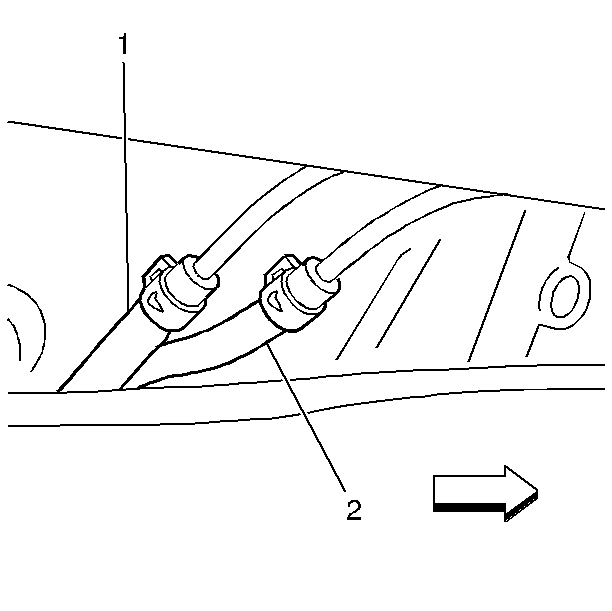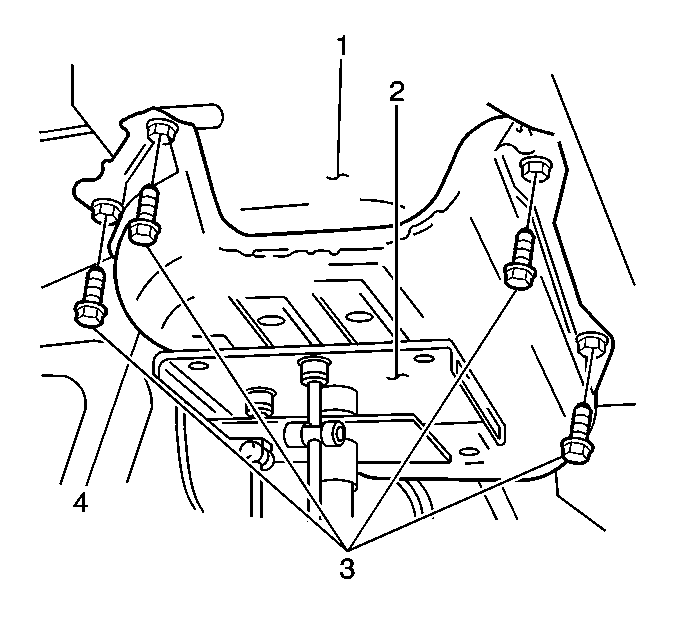Removal Procedure
- Relieve the fuel system pressure. Refer to Fuel Pressure Relief .
- Drain the fuel tank. Refer to Fuel Tank Draining .
- Raise and suitably support the vehicle. Refer to Lifting and Jacking the Vehicle in General Information.
- Disconnect the fuel feed inlet hose (2) from the fuel filter (1).
- Disconnect the fuel vapor hose (2) from the fuel tank.
- Disconnect the fuel return hose (1) from the fuel tank.
- Disconnect the fuel filler hose from the fuel tank.
- Remove the 4 bolts (3) and the fuel tank shield (4) from the vehicle.
- Support the fuel tank with a hydraulic jack.
- Remove the 4 bolts (2) and the 2 fuel tank straps (1) from the vehicle.
- Lower the fuel tank approximately 31 cm (12 in) from the vehicle chassis.
- Disconnect the fuel tank sender assembly electrical connector (2).
- Disconnect the electrical connector (3) from the fuel tank pressure sensor.
- Disconnect the fuel tank breather hose from the fuel tank.
- Continue to lower the fuel tank until the tank can be removed from the vehicle.
Caution: To avoid any vehicle damage, serious personal injury or death when major components are removed from the vehicle and the vehicle is supported by a hoist, support the vehicle with jack stands at the opposite end from which the components are being removed and strap the vehicle to the hoist.





Installation Procedure
- Raise the fuel tank with a hydraulic jack to within approximately 31 cm (12 in) of the vehicle underbody.
- Connect the electrical connector (2) to the fuel tank sender assembly .
- Connect the electrical connector to the fuel tank pressure sensor.
- Connect the fuel tank breather hose to the fuel tank.
- Raise the fuel tank all the way to the vehicle chassis.
- Secure the fuel tank to the vehicle chassis with the 2 straps (1) and the 4 bolts (2).
- Install the fuel tank shield to the vehicle chassis.
- Secure the fuel tank shield to the vehicle chassis with the 4 bolts (3).
- Connect the fuel vapor hose (2) to the fuel vapor pipe.
- Connect the fuel return hose (1) to the fuel return pipe.
- Install the fuel filler hose to the fuel tank.
- Connect the fuel feed inlet hose (2) to the fuel filter (1).
- Lower the vehicle.
- Refill the fuel tank.
- Inspect for fuel leaks.
- Connect the negative battery cable.
- Start the engine.
- Inspect for fuel leaks and repair as necessary.

Notice: Use the correct fastener in the correct location. Replacement fasteners must be the correct part number for that application. Fasteners requiring replacement or fasteners requiring the use of thread locking compound or sealant are identified in the service procedure. Do not use paints, lubricants, or corrosion inhibitors on fasteners or fastener joint surfaces unless specified. These coatings affect fastener torque and joint clamping force and may damage the fastener. Use the correct tightening sequence and specifications when installing fasteners in order to avoid damage to parts and systems.
Tighten
Tighten the strap bolts to 35 N·m (26 lb ft).

Tighten
Tighten the bolts to 35 N·m (26 lb ft).


